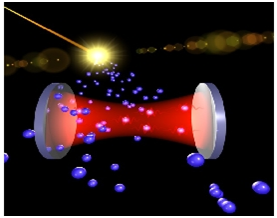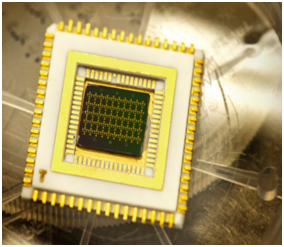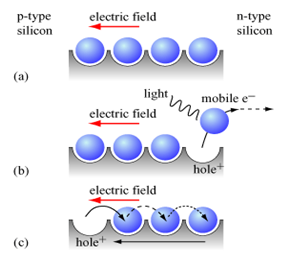Quantum Electronics
Dr. S. S. VERMA; Department of Physics, S.L.I.E.T., Longowal; Distt.- Sangrur (Punjab)-148 106
Quantum electronics is a term that was used mainly between the 1950s and 1970s to denote the area of physics dealing with the effects of quantum mechanics on the behavior o f electrons in matter, together with their interactions with photons. In the field of quantum electronics, scientists study the interaction of radiation and matter on the quantum level. Today, quantum electronics is rarely considered a sub-field in its own right, and it has been absorbed by other fields. Solid state physics regularly takes quantum mechanics into account, and is usually concerned with electrons. Specific applications of quantum mechanics in electronics is researched within semiconductor physics. The applications of quantum electronics help to understand previously inaccessible problems also in fundamental physics, astrophysics, and geophysics.
f electrons in matter, together with their interactions with photons. In the field of quantum electronics, scientists study the interaction of radiation and matter on the quantum level. Today, quantum electronics is rarely considered a sub-field in its own right, and it has been absorbed by other fields. Solid state physics regularly takes quantum mechanics into account, and is usually concerned with electrons. Specific applications of quantum mechanics in electronics is researched within semiconductor physics. The applications of quantum electronics help to understand previously inaccessible problems also in fundamental physics, astrophysics, and geophysics.
Quantum electronic devices
Experts and scientists acknowledged Quantum theory to be the fundamental theory of physics that amalgamate entire physical tools. Any electronic device may be treated to be a quantum electronic device by itself. Experts appreciate quantum electronic devices to be only those devices that kindle alterations between quantum energy levels. Scientists learn the communication or interaction of radiation and matter on the quantum level, in the area of quantum electronics. Researchers in the field of quantum electronics accomplished a large number of developments in the field of optics and radio physics, by employing information from electronics and physics. The transitions between quantum energy levels are of meticulous significance, in the field of quantum electronics. Atoms, molecules and other quantum systems incorporate excited particles. These systems can only have specific, stringently distinct, quantity of energy. When a system emits electromagnetic radiation, in the form of light or radio waves, it moves from a higher energy level to a lower one.
Utilizing knowledge from electronics and physics, scientists in this field have made much advancement in optics and radio physics. The applications of quantum mechanics and quantum optics are to the study and design of electronic devices. Quantum theory is accepted by scientists to be the basic theory of physics that unifies all physical devices. As such, any electronic device may be considered to be a quantum electronic device. Most scientists, however, understand quantum electronic devices to be only those devices that stimulate transitions between quantum energy levels. Machines such as laser and maser are particularly useful in the field of quantum electronics. Lasers radiate light waves in a focused beam within a narrow range of radiation. In quantum electronics, the transitions between quantum energy levels are of particular import. Atoms, molecules and other quantum systems contain excited particles. These systems can only contain certain, strictly defined, amounts of energy. When a system gives off electromagnetic radiation, in the form of light or radio waves, it moves from a higher energy level to a lower one.
 Researchers have created the first electronic device that can cool electrons to -228 degrees Celsius (-375F), without any kind of external cooling. The chip itself remains at room temperature, while a quantum well within the device cools the electrons down cryogenic temperatures. These cryogenic, quantum well-cooled electrons could allow for the creation of electronic devices that consume 10 times less energy than current devices, according to the researchers. A quantum well is a very narrow gap between two semiconducting materials. Electrons are happily bouncing along the piece of semiconductor when they hit the gap (the well). Only electrons that have very specific characteristics can cross the boundary. In this case, only electrons with very low energy (i.e. cold electrons) are allowed to pass, while hot electrons are sent back from whence they came. The well is created by sandwiching a narrow-bandgap semiconductor between two semiconductors with a wider bandgap. Once a stream of cold electrons is coming through the quantum well, other components can be taken onto the circuit- such as transistors.
Researchers have created the first electronic device that can cool electrons to -228 degrees Celsius (-375F), without any kind of external cooling. The chip itself remains at room temperature, while a quantum well within the device cools the electrons down cryogenic temperatures. These cryogenic, quantum well-cooled electrons could allow for the creation of electronic devices that consume 10 times less energy than current devices, according to the researchers. A quantum well is a very narrow gap between two semiconducting materials. Electrons are happily bouncing along the piece of semiconductor when they hit the gap (the well). Only electrons that have very specific characteristics can cross the boundary. In this case, only electrons with very low energy (i.e. cold electrons) are allowed to pass, while hot electrons are sent back from whence they came. The well is created by sandwiching a narrow-bandgap semiconductor between two semiconductors with a wider bandgap. Once a stream of cold electrons is coming through the quantum well, other components can be taken onto the circuit- such as transistors.
Lasers and masers are the primary devices used in quantum electronics, as each of these focuses energy into a tight, focused beam. Lasers and masers can be used to excite these atoms or molecules into higher states of energy. This makes the light that a laser emits monochromatic, whereas most light sources emit multiple colors of light. The frequency of the microwaves is stable and does not deteriorate as readily as standard microwaves do. The application of this machine allows communication towers that emit sound waves in the microwave radiation range to send information over great distances with little distortion. Usage of the term overlapped early work on the quantum Hall effect and quantum cellular automata. Using lasers, atomic clocks, and the techniques of single photon detection, experimental measurements are being made. Optical systems involving new laser designs and new types of detectors are being developed.
Applications
Researchers within the Quantum electronics group are exploring the electrical and optical properties of nanometer scale semiconductor devices. At these small length scales the device properties are no longer administered by semi-classical physics, but are instead determined by quantum mechanical effects. Quantum electronics is devoted to the study, design and development of opto-electronic devices that rely on the physics of the very small – quantum mechanics – to operate. Many examples of such devices, including semiconductor laser diodes, are cornerstones of applications that touch our everyday lives including CD and DVD players, and optical fiber communications without which the internet would not exist. Lasers and associated devices are currently being broadly used in various fields such as materials working, communications, medical surgery and therapy, printing, semiconductor processing, chemical processing, remote sensing, etc. They also provide a unique research tool that has had a substantial effect on many scientific regulations and also they have a major entertainment value through the development of laser light shows and holographic demonstrations. The other chief division of the field of quantum electronics handles the interactions of coherent light with matter and again leads to a wide range of all-optical and opto-electronic devices. The tools are quickly performing in areas such as communications, computing and military equipments.
Research advances
Research advances in quantum electronics are helping to understand the properties of valence band holes in semiconductor nanostructures. It has been known for over 100 years that electricity is semiconductors is carried by negatively charged electrons and positively charged holes However while the properties of electrons are very well understood, the understanding of holes (particularly when confined to move in nanostructures) is much less well understood. For example, as we are told that valence band holes are essentially just heavy electrons, with a positive charge and a positive effective mass. This is incorrect. Holes are spin-3/2 particles whereas electrons are spin-1/2. It is only in the past few years that we are beginning to understand just how different holes are from electrons. For instance, whereas electrons have a well defined dipole moment that couples their spin to an externally applied magnetic field, holes also have quadrupole and octopole moments that have no equivalent in electrons. These unique spin properties have led to proposals for novel spin based hole transistors, that could run much faster and with lower power than conventional devices that rely on the charge of electrons, as well as new types of quantum bits for quantum information applications. But much work remains to be done before we even have a basic understanding of the spin properties of holes. Researchers are also engaged in the area of the theory, modeling and simulation of infrared and terahertz quantum optoelectronic devices including quantum cascade lasers, quantum well infrared photo detectors and quantum dot infrared photo detectors.
 Researchers are studying the mutual interaction of heat, light, and electricity in nano and micro scale materials and devices. The quantum behavior of electrons and light, as well as the interaction mechanism between them, are responsible for a wide variety of complex physical phenomena. Gaining a better understanding of these interactions directly assists in the improvement of device and circuit performance in applications such as energy conversion, computing and communication technologies. This mutual interaction can be used to improve device performance either in energy conversion or in information processing applications. For example, designing of a micro refrigerator on a chip could be used to remove hot spots in microprocessor chips. Researchers have also developed novel AC imaging techniques to obtain thermal maps of active devices with submicron spatial resolution and microsecond time resolution and are applying similar techniques to improve imaging in turbid media using ultra fast lasers. Researchers are also working to achieve high efficiency and high power density direct thermal to electric energy conversion by using embedded metallic nanoparticles and multilayer for hot electron filtering and thermal conductivity reduction in order to improve the intrinsic thermoelectric properties of the material. These capabilities, together with a wide range of other optical and electrical techniques, are being used for thermal characterization of thermoelectric materials and devices, power electronics, LEDs, and solar cells.
Researchers are studying the mutual interaction of heat, light, and electricity in nano and micro scale materials and devices. The quantum behavior of electrons and light, as well as the interaction mechanism between them, are responsible for a wide variety of complex physical phenomena. Gaining a better understanding of these interactions directly assists in the improvement of device and circuit performance in applications such as energy conversion, computing and communication technologies. This mutual interaction can be used to improve device performance either in energy conversion or in information processing applications. For example, designing of a micro refrigerator on a chip could be used to remove hot spots in microprocessor chips. Researchers have also developed novel AC imaging techniques to obtain thermal maps of active devices with submicron spatial resolution and microsecond time resolution and are applying similar techniques to improve imaging in turbid media using ultra fast lasers. Researchers are also working to achieve high efficiency and high power density direct thermal to electric energy conversion by using embedded metallic nanoparticles and multilayer for hot electron filtering and thermal conductivity reduction in order to improve the intrinsic thermoelectric properties of the material. These capabilities, together with a wide range of other optical and electrical techniques, are being used for thermal characterization of thermoelectric materials and devices, power electronics, LEDs, and solar cells.

